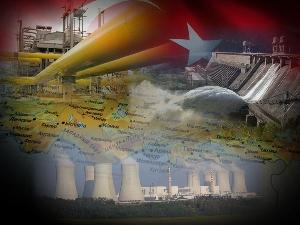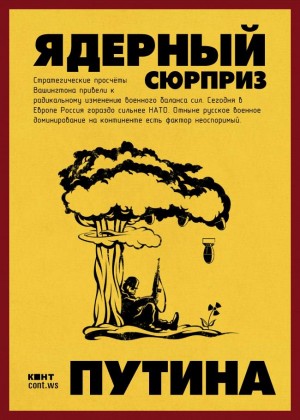
Usually, when they start talking about atomic weapons, they immediately remember about nuclear bombs, missiles, shells. Invented more than 70 years ago, it became the best lever of deterrence and allowed the world to avoid another world massacre. The country’s nuclear arsenal today allows it to cool down the militant ardor and forces the enemy to retreat. This weapon exists to protect, and hopefully will never be used.
The article will focus on a fundamentally different type of atomic weapons, the use of which is not only welcome, but also allows the owner country to pursue a much more active foreign policy and solve in its favor such conflicts that seem to be finally and irrevocably lost.
Why do you think the United States, as soon as they manage to squeeze Russia out of another country, first of all cares about shutting down all nuclear reactors previously built in them by the Soviet Union and energy projects in general?
Everything is very simple. Energy is the blood of the economy. Not a single superpower in the last 200 years has been built on the basis of any looms, iPhones or robots. But they all had their own energy zest, which lifted them above their opponents.
Britain became the ultimate mistress of the seas and the main factory of the world, having received cheap and high-quality Cardiff coal. It was he who became her main competitive advantage over others.
In the second half of the XIX century, more than half of the coal burned in the world was English
The United States was able to throw the British off the throne thanks to control over oil. The fatal fate of the under-superpower – Japan – adds extra colors and shows that there are no exceptions to this rule. A country may have a first-class industry, a fanatical and committed population, but this is not enough. For true independence, any country needs an independent energy sector. For a country to become a superpower, it must impose itself on a significant part of the world as an energy supplier. On the contrary, any country, having energy dependence on its neighbor, is doomed to be its faithful ally, or it will be turned into an economic ruin.
This is well understood in the United States, and therefore, as I have already said, the first thing they do is squeeze Russia out of the energy markets of their newfound satellites, and where they failed to do this, they very quickly roll back.
Ukraine, doomed to friendship with Russia

RUSSIAN RUSSIANS ARE THE GOAL OF THE UKRAINIAN EVENTS – TO DESTROY THE RUSSIANS BY THE HANDS OF THE RUSSIANS THEMSELVES”
Ukraine was supposed to be the main prize for the United States in its campaign to the East, which began 30 years ago. Before the decisive throw and destruction of Russia, it was Ukraine that was destined to play the role of a springboard and supplier of expendable military materials (I mean people who are ready to die in a war with the Russians). During this time, the country was involved in all imaginable and unthinkable anti-Russian projects, the elite was bought, the population was periodically brainwashed. Time after time, Washington made attempts to strengthen itself and invariably rolled back. The last and hopefully final attempt was made in 2013. Kiev and the rest of Ukraine, with the exception of Crimea and several eastern cities of the country, were quickly taken under control. And then, once again, Washington was disappointed.
Let’s leave aside the military campaign and look at the energy aspects of the confrontation. Already at the beginning of the winter of 2014, Ukraine had to be saved. To save it so that it does not collapse ahead of time. That is why in that difficult winter for Ukraine she was helped from Moscow. They helped because they were not ready to return to Kiev yet.
The same thing happened next winter, and I am sure that next winter will once again show that Russia will not let Kiev fall until it is ripe for its absorption. If Moscow had returned Ukraine at the end of 2014, in a few years it would have been raking out the problems of 30 million people who hate it because its tanks did not allow them to fully enjoy European life. And so they still have plenty of time for this.
That is why the attack on Mariupol was stopped in August 2014 and the APU, which at that time were the remnants of broken and completely demoralized detachments, unable to resist for a long time, were not finished off.
Ukraine, obviously, could not survive the first winter without the help of its neighbors, and therefore Russia began to “aggressively” supply it with gas, coal and fuel for nuclear power plants. Often in debt, realizing that these debts will never be repaid.
2.5 years have passed, and Ukraine’s energy dependence on Russia has only increased in percentage terms. Neither the energy saving program (freezing of the population and destruction of industry) nor the transition to alternative sources helped Kiev. Russian gas was replaced with Russian coal, which for some reason became known as South African, oil and gasoline – with Russian liquefied gas (up to 50% of liquefied gas in Ukraine is of Russian origin). And the transition to nuclear rods from Westinghouse is associated with a significant number of organizational and technological problems and cannot be implemented even in the medium term.
Only the technological transition on one test unit will take at least 8 years and then at least 4 more years, when it will be possible to completely abandon the Russian rods. No way faster.
But Kiev and Washington obviously don’t have these 12 years. Summing up the results of attempts to separate Ukraine from Russia, we must admit that, despite enormous efforts and well-planned hybrid strikes, they failed. Kiev is still critically dependent on Moscow, and its regime can be brought down at its will within one calendar year. And it will be brought down as soon as everything is ready to collect the fruits of this collapse.
THE IDEOLOGY OF GENOCIDE IN UKRAINE
The date is currently being viewed no later than 2020. But the regime still needs to reach it, which means that Moscow will continue to help its opponent, despite the rhetoric and demonstrative spitting in its direction from Kiev.
I know it sounds crazy, but that’s exactly the logic of modern hybrid wars. To understand it, let’s turn to another case.
Affectionate embrace of Turkey
A significant event took place yesterday. A contract was signed in Turkey for the construction of the first stage of the Turkish Stream, according to which Russian gas will bypass Ukraine to Turkey and Europe. Today it is easy to build dizzying plans in your head about the advantages that Russia will receive in the future. And on November 24, 2015, it seemed to many that Russian policy in the Middle East had failed and the country was facing a long and tough confrontation with the Turkish Republic, which, of course, in this case would be helped by all “progressive humanity”.
It seemed to many, but not to those who, a few years before, had made such a turn… impossible.
Turkey’s economy is critically dependent on energy imports. Surrounded on all sides by enemies, she could not rely on a reliable ally. The Turkish “two-vector approach” at that time, in fact, was no different from the Ukrainian one, with one exception: initially all its energy projects were not tied to Russia. But gradually, step by step, Moscow entered the energy market of Ankara. In the beginning, it ensured Turkey’s independence from the West, allowing it to begin to get impudent and put into practice the implementation of its neo-Ottoman project. At the same time, energy consumption was growing in the country, and before the crisis in the Middle East (2011), this growth was up to 9% per year. The power system did not have time to fulfill all the requests of the rapidly growing industry and the service sector, and therefore constant blackouts in the provinces were normal practice. It was obvious to the Turkish leadership that a breakthrough was needed, otherwise they would have to forget about the Turkish economic miracle. In 2010, Turkey, after much hesitation and searching, concluded an agreement with Moscow for the construction of a four-unit Akkuyu NPS with an installation capacity of 4.8 GW.
At that time, the entire energy sector of Turkey had only 21 GW of generation
And taking into account the fact that half of the country’s generation consisted of thermal power plants, as well as taking into account the import of a significant share of coal and gas from Russia, Turkey’s dependence in the energy sector has become critical and even strategic. All this played a role during the crisis of 2015. Despite desperate attempts on the part of the United States to sever these new economic ties between Moscow and Ankara and push the two countries head-on, they failed.
Moreover, we must understand that this state of affairs will not last 5 or even 10 years. The service life of the new nuclear units will be 50-60 years, and the gas pipe – at least 30 years. And all this time, Turkey will not have a desire to put sticks in the wheels of Russian diplomacy without very strong arguments, and if it suddenly does, it will regret it very quickly, as it happened at the end of 2015.
Hybrid Energy Wars
What will be the energy of the future? Whoever is the first to answer this question correctly has every reason to claim the role of a future superpower. There are exactly four applicants for today. Or rather, two, and two should be kept in mind.
To begin with, two underplays. These are Europe and China.
Europe has made a bet on two main directions. The first is wind and sun, and the second is a new generation of nuclear power plants from AREVA. With the new nuclear power plant, so far everything is not as good as the developers would like, and the wind and the sun, simultaneously with the decommissioning of the old nuclear power plants in Germany, have led the continent to a shortage of basic capacities and an increase in the cost of electricity, which is beginning to slow down its economy.
China is growing very fast. Its energy needs are so great that for a very long time they will not be able to be satisfied at the expense of internal resources (if at all). So far, the country is totally dependent on foreign energy technologies (nuclear power plants) and fossil fuels. In the foreseeable future, China is not able to get rid of it, and therefore Beijing will be vulnerable and dependent for a very long time and will not be able to be a superpower in the full sense of the word.
Rather, it will be another “pro-Russian” and very big Japan
So, the first real player is the current only superpower of the United States. It has made a bet on more complete extraction of traditional oil and gas and is developing these areas. Their calculation is that deposits with cheap prime cost will soon run out, their shale will be in demand and will feed the country for several more decades, and they will become a trendsetter, a source of technology, which will provide them with advantages. It cannot be said that they tried only this direction. Also, the United States was one of the first to try to subdue nuclear energy. To do this, the political levers and developments of Westinghouse were used. But the latter has not yet managed to master the construction of a new generation of reactors, and probably will not be able to do so soon. In any case, they are already far behind Russia in the nuclear power industry and are unlikely to be able to catch up with it. At the same time, Washington’s political levers are weakening, and countries are getting out of their control one by one, bowing to their geopolitical opponents.
The second player is Russia. She, like no one else, has all the possibilities for a breakthrough. And in different directions. Possessing colossal energy resources (from hydro to coal, oil and gas) and having made a qualitative breakthrough in nuclear energy (having overtaken competitors at the same time), it currently provides the world (primarily Eurasia) with a lot of unique energy projects.
Asian Super-ring: creation of a new 15 kW energy cluster in the Far East for looping the energy systems of Russia, China, Japan and South Korea into one. This will not only tie the three leading Asian economies to it, but will also allow them to deploy infrastructure for future projects in their Far East at their expense.
Development of traditional gas and oil fields in the Arctic and the Far East. By doing this, the Russian Federation will be able not only to bind new consumers to itself, but also to prevent the American shale strategy from working (the fight against which is being waged today on all fronts)
And finally, the construction of new nuclear power plants around the world. Today, contracts have been signed and 36 nuclear power units are being built (plus 8 units are being built in Russia). This is about half of the world market (if we count American and European long-term construction projects). Moreover , the geography of construction is remarkable: Turkey, Hungary, Belarus, Iran, India, Vietnam, Bangladesh, China, Finland. Agreements have also been concluded with Egypt and Jordan. There are several more projects on the way.
What does this mean for Russia
The construction of stations and their maintenance are projects for 60-70 years (with the extension of the life of the blocks – up to 100 years). For a hundred years, the country that built the nuclear power plant will be like Ukraine dependent on Russia in the energy sector.
And it will also bring her money. A lot of money.
RUSSIA HAS A CONTROLLING STAKE IN NUCLEAR ENERGY
And all this time, the probability of a conflict between Rosatom’s partner countries and Russia, thanks to the construction of nuclear reactors, will decrease. The example of Turkey today is very indicative. If we look again at the geography of nuclear construction sites, we will see that Russia surrounds itself with countries that are atomically dependent on it, and also builds new nuclear power plants in regions that are critically important to itself. This is the atomic hybrid weapon that can and should be used. And it’s already in use. The current gain in the new nuclear market allows Moscow to pursue an increasingly offensive policy in the world and is an important lever for solving its geopolitical tasks. Today we see this very well in the examples of Ukraine, Turkey, Iran, Hungary and Finland. Tomorrow it will be other countries in Asia and the Middle East, and the day after tomorrow Rosatom will begin to work actively in Africa and South America.
Even the United States has not escaped this fate. Very soon, Russian nuclear fuel will begin to conquer the market of its main political opponent.
Meanwhile, a new ambitious project is coming to the finish line in Russia: the closure of the nuclear cycle, which in the future a couple of decades will allow the industry to develop rapidly without increasing the raw material base, dramatically reduce the problems with spent nuclear fuel and the cost of electricity. And also, if this concept is successfully promoted in the world, it will not only provide the country with huge financial revenues for decades, but will also become another strategic nuclear shield of the country.


























